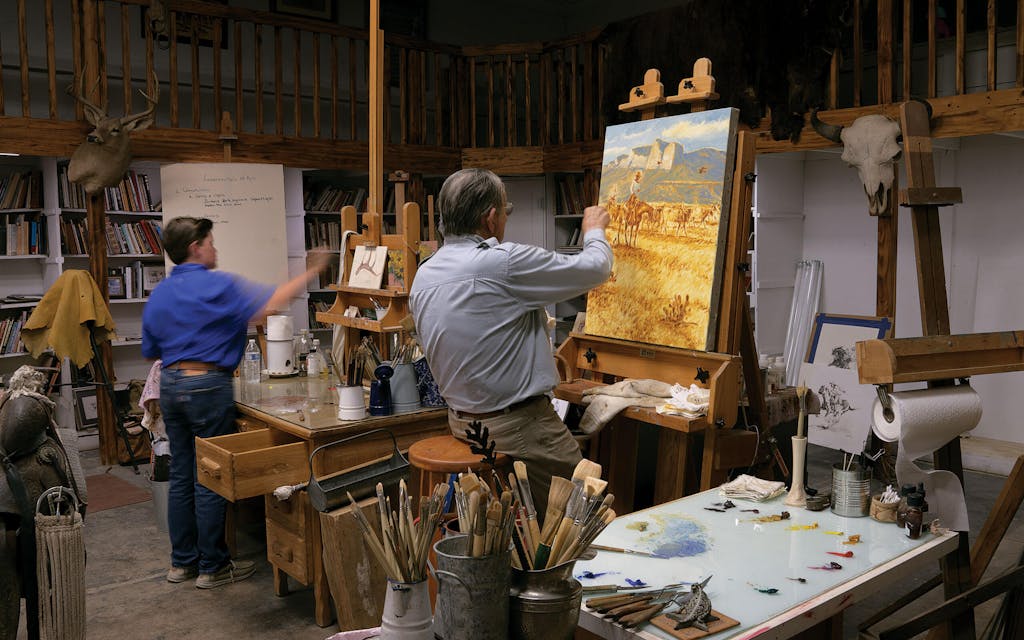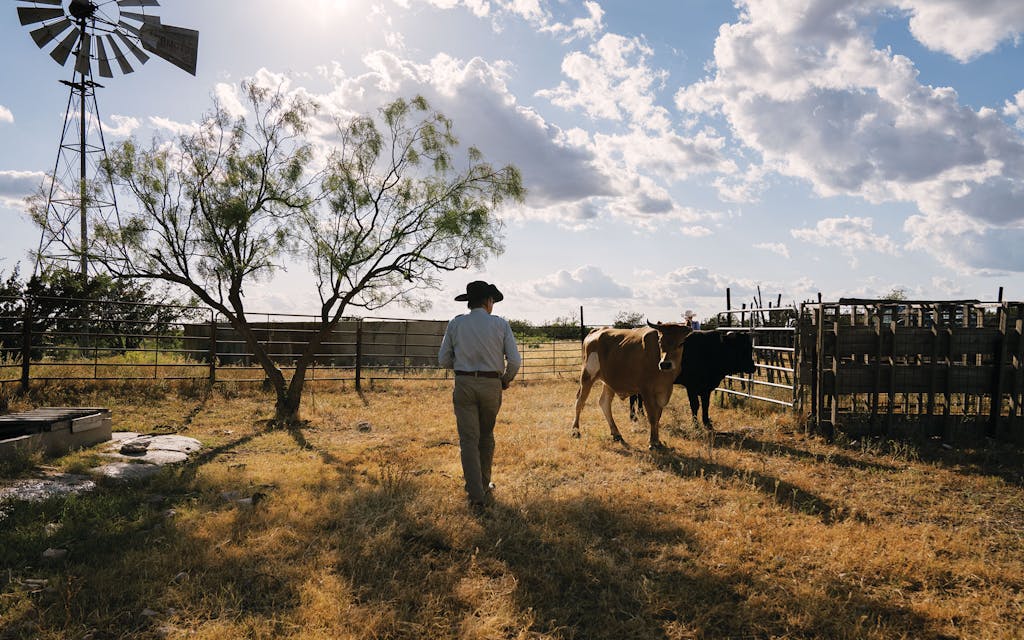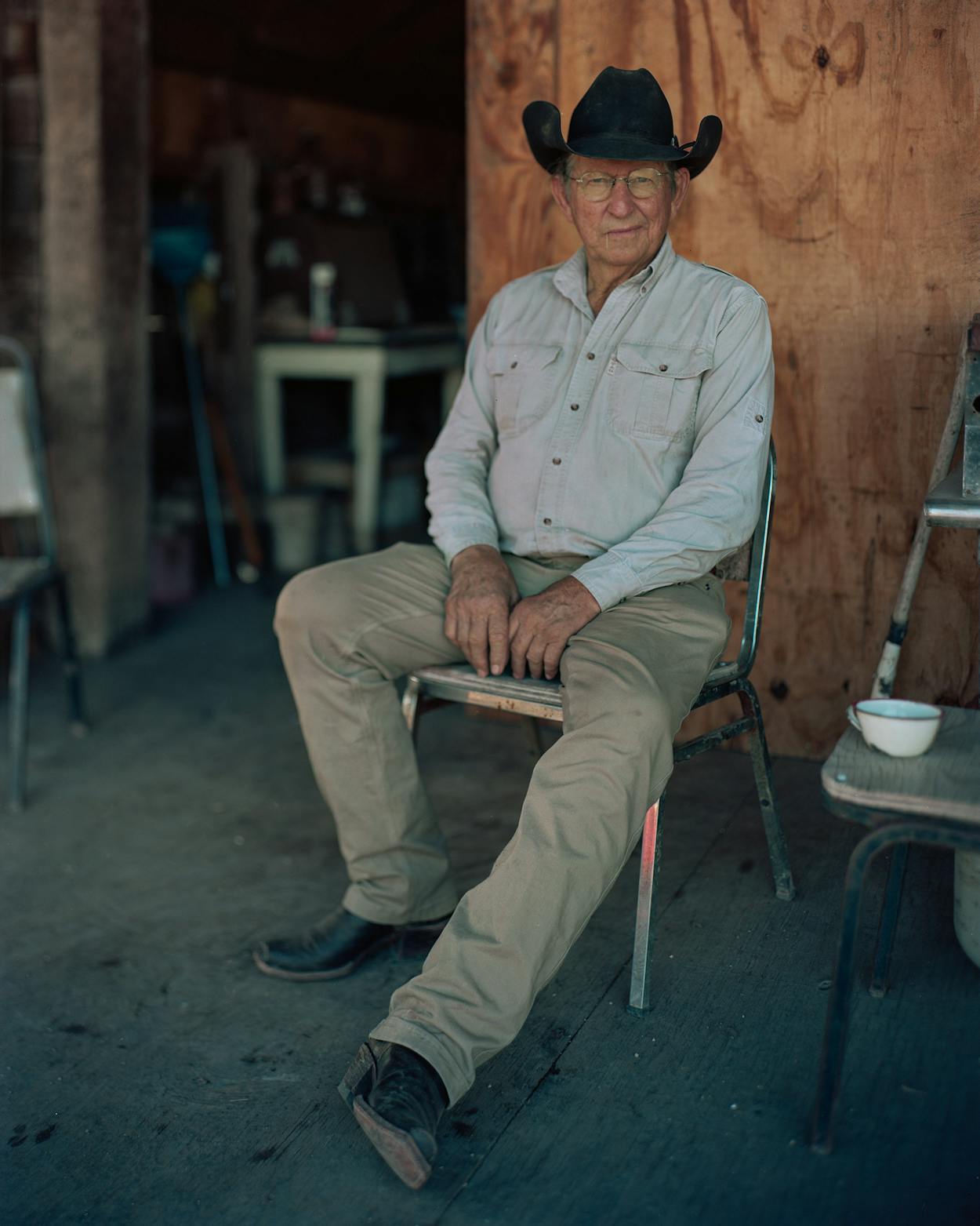On a Saturday of gray bluster, ten-year-old Isaac Rodriguez slipped through the back door of the old mercantile in Sheffield, some seventy miles southeast of Fort Stockton. A fire popped in the woodstove as Mike Capron looked up to greet him. This is Capron’s art studio, a cavernous circa-1900 building whose interior contains a wonderland of objects, an encyclopedic sampling of Capron’s interests, including but not limited to livestock magazines, saddles, spurs and bits, turkey feathers bristling in coffee cans, finished paintings in frames and some in progress on easels, drawings of hounds and horses, art supplies of all sorts, trophy mounts, books, a framing workshop, bronzes of bucking broncs, and a table dedicated to playing dominoes.
The building is situated on the town’s main drag, not too far from the community center and the Tin Cup Cafe, which appears closed this morning. As a matter of tradition, and in a gesture of communicative shorthand, Capron hangs an American flag from the front porch to indicate he’s there and welcoming of company. It might sometimes seem that the flag is the only thing stirring in Sheffield, population 174.
“Lookee here,” Capron called out as Isaac sidled up. “He’s one of my helpers when he doesn’t have to go to school. He’s an artist, makes clay figurines. They’re all in the corner, and he sells them to whoever comes through. What’re you doin’ today?”
Capron is silver haired and sports rimless glasses. Pens and pencils sit sentinel in the breast pockets of his wool vest. When he was a teenager, in Kansas, a family friend gave him a book on the Western painter Charles Russell, and Capron’s world broke open. “I’ve still got that book, still look at it,” he said. “The education of a man who painted like Charlie Russell, who painted his passion and made a living doing what he wanted to do, impressed me since day one. I started right away drawing what I was doing, wherever I was.”

At twenty, Capron was cowboying on the Mescalero Apache reservation, in southern New Mexico, chasing seven thousand rangy Herefords on seven sections of land. “We had seventy-five horses in the remuda,” he said. “Each cowboy had five horses in his string, and we’d rotate them to get the freshest one every day. We rode all day every day.” Even amid that isolation, his draft card found him. “My interest level in Vietnam was low,” he said. “I thought, ‘There has got to be a plan B.’ ” Instead of reporting for duty right away, Capron met with a Marine Corps recruiter, who offered him a six-month deferment in exchange for a three-year commitment. Deal.
Immediately he set out for Montana, with the goal of seeing as many Charles Russell paintings as he could find. He went to galleries in Helena, Bozeman, Great Falls. “Anywhere there was a Charlie Russell original,” he said. In Jackson Hole, Wyoming, he stood mesmerized by Russell’s When Horses Talk War There’s Slim Chance for Truce. In it, cowboys at daybreak are readying for work. One holds the reins of a roan horse he intends to mount. The set of the cowboy’s head is determined. So is that of the horse, though of an opposite determination. “It was just gorgeous,” he remembered. “The message was of a man and a horse fixing to go to war. The title was so strong because horses don’t always want to go with you. The expression of the men around was ‘this is gonna be a show.’ I love the attitude, the storyline of the painting.” As he headed to the Marines, he thought, “That’s the plan. I want to paint like Charlie Russell.”
Hearing Capron pause, Isaac approached, bearing a small clay horse. Capron examined it and returned it to the boy. “You better put some ears on it,” he counseled. “Ears are horrible details, but they’re what gives it expression.”

In September 1965 Capron arrived at the Marine Corps Recruit Depot in San Diego, where, after basic and infantry training, he was sent to communications school to learn Morse code. After class, Capron worked on assignments from the Famous Artists School, a correspondence course that advertised in the backs of magazines such as Field & Stream and Outdoor Life. “They would send you a book and lessons. You’d do the lessons, send them, and they’d critique them and send them back. We had instructors like Robert Fawcett, Norman Rockwell—tremendous instructors who were on this staff. And I just loved it.” He drew on the ship on the way to Vietnam, though not many Famous Artists School lessons were completed once he was in country. “I did draw in Vietnam a bunch, but on C-ration cartons. Mail was hard to keep up with.”
As a radio operator attached to a mortar squad, Capron carried both pistol and radio. Halfway through his thirteen-month tour came a night of particular reckoning, when Capron said he thought, “This is it, kid.” Pinned down by guerrillas and beset by heavy questions about what they all were doing and why, Capron prayed. “There were no big lights, no big voice, but a feeling of peace came over me that I couldn’t believe,” he said. “The message was: ‘This could be the first day of eternity, and I’m here to take care of you.’ And I’ve had that same peace since then about picking up a brush or getting on a horse. It’s not that I haven’t been bucked off or painted a masterpiece every time, but I have had faith in God ever since.”
Capron’s story abruptly cut off as the studio’s back door opened and Larry Bishop and his wife, Shelly, entered.
“What’re you doin’?” boomed Capron.
Bishop grinned. “Come to see what you’re doin’.”
Bishop had commissioned a portrait of his late father, and Capron used a photograph and conversations with Bishop and his father’s old friends to get a sense of the man. Capron handed him the finished piece, an image of a middle-aged man gently smiling. The color rose high on Bishop’s cheeks.
“My dad’s been gone five, six years,” he said. “It looks like he’s right here.”
Commissions make up a good portion of Capron’s work these days. He keeps several projects going, in varying stages, at the same time. He worked on the Bishop picture concurrently with a portrait of a friend’s dog. A third commission, of cowboys moving Longhorns along the Chisholm Trail, sat on an easel, awaiting final touches. While its Western subject matter registers immediately, the work is subtly electric in its use of color. The cowboy on the right, wearing a wild rag around his neck and a revolver at his hip, rides a blaze-face horse that is colored periwinkle and lilac. The grass is lime, umber, and orange. The painting is alive with movement, the curves of limbs and horns making the eye travel all over the canvas. The foremost steer gazes at the viewer, about to step off the canvas. “I can look at those cattle and see them anticipating crossing the Red River, and those cowboys making sure that they are lined out,” Capron said. “I love that moment of leaving camp and the excitement of all the things that can happen to man and horse and work.”
The start of an artwork comes to Capron in different ways. Sometimes a title announces itself, and he makes the painting to meet that, or perhaps it’s a moment of local history that interests him or something he sees one day. He hurtles from one project to the next, and if his ideas stall momentarily, he prays about it. “Within twenty-four hours there will be something that says, ‘Paint me.’ I’m constantly thinking of good subjects, beautiful sights, light, gesture, proportion.”


At midday, Capron looks at Isaac, who has placed his horse sculpture, now eared, with others in the corner window. “You want to have lunch with us?” The noon meal is served at the Capron home next door, a former hotel. Capron and his wife, Anne, met at a Christmas party, in December 1968, and got engaged on their third date. He promptly left for a welding job in Australia, and it took so long to hear from him that Anne wondered if he was gone for good. “The cowboy done rode away,” she said. Finally, his letters did arrive, with kangaroos drawn across the envelopes. Six months later, he returned to Texas. “I want to go back to the ranch, and I want to punch cows,” he told her. “She said, ‘Good.’ I left a twenty-five-hundred-a-month job and took a two-fifty-a-month job on a ranch. And we’ve been doing it ever since.”
For the next couple of decades, Capron found ranch work around the Salt Flat area near Guadalupe Peak, a place so remote that going for groceries could be a hundred-mile trip. One day he showed a ranch to a potential buyer, who told him that space, not simply land itself, was the most valuable commodity. “Ever since that day I really appreciated the meaning of the word and how much of it is diminishing in this world,” Capron said. “That’s why I paint—because I love to paint space. I went into the service, and I was itching to go home. They asked why, and I said, ‘I can’t see far enough.’ I got to the ocean and thought, ‘This is more cramping than anywhere I’ve ever been. I can only see to the horizon, fourteen miles. I can’t see no mountains.’ At home we can see a hundred miles of dirt and dust and clouds.”
The family moved, in 2004, to Fort Davis, where Anne taught elementary school and Capron day worked throughout the Big Bend and painted in a small studio in town. Ten years ago Anne inherited part of her family’s ranch,
eighteen miles east of Sheffield. It lacked a house, so they bought and renovated Sheffield’s former hotel and then the old mercantile next door. “It has just fit us like a glove,” he said. “We’ve dearly loved it. The ranch is a beautiful expenditure. We go out there every day, watch it, take care of it, improve it. That’s a full-time job in Sheffield—art and the ranch.”
Anne set out country steak, rice, beans, and gravy. Mealtime talk covered how Anne’s African gray parrot prefers Mike to her, the musicality of a burro’s braying song, and the benefit of horses having a job. “It’s amazing how much animals feel connected, appreciated, to be part of the routine,” he said. “People aren’t that different.” He spoke on the eeriness of cowboying in the vicinity of Chinati Peak, a mountain southwest of Marfa where, according to Capron, old Mexican men told him the devil resided in a cave. “I have story after story about the top of Chinati,” he said. “There was a wreck every time we went up there of some nature.” Once, while camped overnight, his spooked companion admitted to hearing someone ride past with a pair of Chihuahua spurs jingling. “I said, ‘Well, that’s possible.’ ”
Capron’s curiosity—his pleasure in plumbing the why of things—never lets up. A weanling heifer at the ranch has escaped her pasture and shown up at the neighbor’s. “I need to ride that west fence to see how that heifer got out, why she left, where she left. It’s gonna be a good story when we figure it out. If we ever do.”

After cake, Isaac scooted off to other Saturday occupations and Capron jammed a battered black hat on his head, feathers in the band. He and Anne clambered into a Suburban for their daily trek to the ranch. The road climbed chalk-colored, flattop buttes. “I have always related the consistency of work ethic with horses and art,” he explained as he drove. “If you maintain a regular schedule of painting every day and riding every day, you will increase your productivity and efficiency, and it makes for a much larger comfort zone. If I’m riding, I’m paying attention to how the light looks and all the things, from animal tracks to fences that need mending to how the animal traffic’s moving, whatever’s going on. I’m always retaining information on how something looks. It becomes habitual. You paint what you know. The more information you get down, the better.”
Horsemanship, he continued, is like dancing. “You’re working together. If they’re comfortable, the horse will go with you. If you hit the rhythm of music, you’re not paying attention with right foot, left foot—you’re dancing.” Painting is the same way. “I can go to mixing paint, and things will fall into a rhythm on the canvas. You get to dancing on the canvas with the brush, and it becomes harmonically beautiful. It becomes a rhythm of constant practice, a comforting exercise. You learn something every time you go to the easel or go horseback,” he said. “The more intent we become with our passions, the more possibilities we uncover, the more things we see, the more things we feel.”
Capron slowed to look at a group of cows and calves amid the cedars. No sign of the wayward heifer’s escape route. He stopped by a year-round spring and then headed to a site called Dead Cow Camp, where he dumped feed for his horse and discovered a mouse situation inside a cabin there built entirely of railroad ties. As he descended the canyons on the way home, the gray day grew somehow grayer, the sky almost lavender. Such things should be noticed. “I love to create the atmospheric look of the Southwest,” he said. “Not so much dramatic sunrises but the light and how it plays on subjects all day long. Space is so important to me, a natural ingredient I’ve always pursued. I was born in eastern Kansas, went to school in Oklahoma and Abilene, but I never got comfortable until I crossed the Pecos River and got to the Chihuahuan Desert. The colors, the distance—I was home.”
This article originally appeared in the September 2023 issue of Texas Monthly with the headline “The Space of a Day.” Subscribe today.
- More About:
- Art








